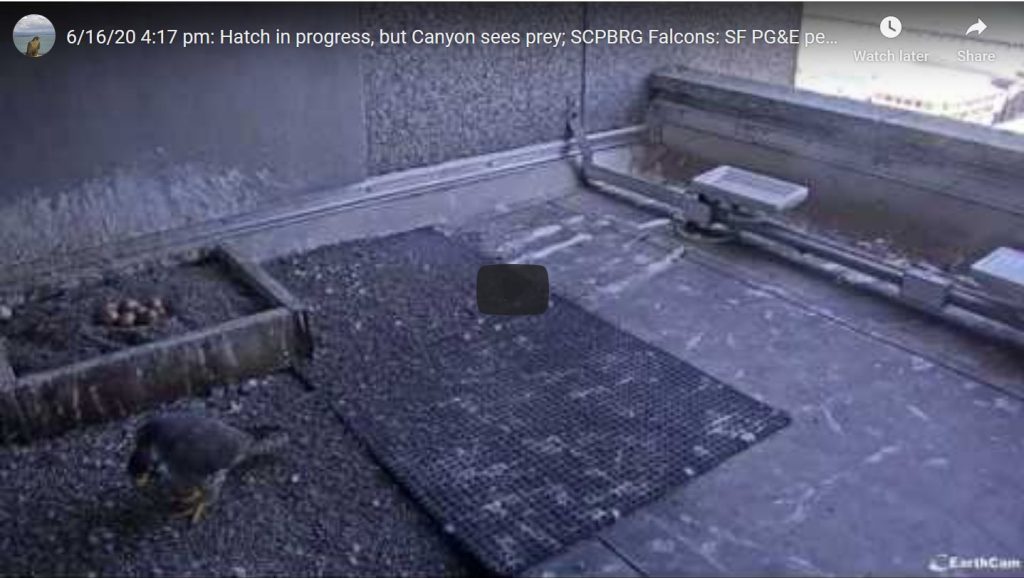
Recent peregrine news out of San Francisco is sadly familiar. SFist reports that people watched the falconcam in horror as a male peregrine, nicknamed Canyon, killed and ate his first hatchling at the PG&E nest.
We know what this is like. Every year from 2016 through 2019 Hope, the female peregrine at the Univ of Pittsburgh’s Cathedral of Learning, killed and ate some of her chicks as they hatched. Most years she ate two of them. In 2017 she ate only one. Morela replaced her in October 2019.
Read the SF news here https://sfist.com/2020/06/18/bad-news-male-falcon-eats-young/ and if you have a strong stomach watch their video. Hope’s behavior is mentioned in the article.

Peregrines eating their hatchlings is so unusual that in the 20 years I’ve tracked it I know of only four peregrines who’ve done it:
- Hope at the Univ of Pittsburgh Cathedral of Learning, 2016 through 2019
- a female at UMass Amherst in May 2017
- a female at a wild cliff in Wyoming where fire retardant was sprayed (can’t find the link)
- Canyon at San Francisco PG&E, June 2020.
Some of you are wondering if this male could be one of Hope’s offspring. No, for at least two reasons:
- This unbanded young male peregrine, nicknamed Canyon, hatched in 2019. All of Hope’s offspring from 2016 through 2019 are banded. An unbanded male born in that timeframe cannot be one of hers.
- Canyon is too far away to have dispersed from Pittsburgh. San Francisco is the other side of the continent.
As crazy as 2020’s failed nesting season has been at the Cathedral of Learning, at least we have been spared this.
(screenshots from SFist article)
How many eggs are in the nest (7 or8)? It looks to be a lot more than we’ve ever seen here in Pittsburgh.
I believe there are 7. Val laid some eggs with her prior mate before he was driven out by the new male, Canyon. Then she laid more eggs.
I have heard of male mammals who killed offspring of males other than themselves (lions). Could our new bird-aside be related in concept.
Aside: in my today’s “gmail news,” TWENTY YRS of tracking data of mideastern eagle.
If there are 4 instances of this behavior recorded, it must be within the repertoire of peregrine behaviors. With webcams becoming more common, we may witness more of it. Although not standard behavior, fortunately, it may well not be that unusual, either.
Kate- you said that Val laid some eggs with her prior mate before he was driven out by the new male, Canyon. Could it be that it was not his chick?
Lori, it’s possible that it was not his chick — about a 50-50 chance. I’m not sure how he’d ever tell though. See other comments for other possibilities.
This site about Peregrines in Bryce Canyon NP mentions PCBs in the context of infanticide, although there aren’t any details. It’s under “Conservation,” and the link is
https://www.nps.gov/brca/learn/nature.htm
There’s also a report of a female Peregrine in Canada who killed and consumed her nestlings. It suggests that weather may have played a role. WARNING: the report contains a very gory photo of the female killing a nestling.
https://www.gov.nu.ca/sites/default/files/arctic_raptors_project_2013_report.pdf
I think there’s some consensus that this instance was less of a “normal” behavior and more a result of the male’s immaturity and inexperience (he’s still has juvenile plumage so is probably only about a year old). He was alone and seemed a bit confused and unsure of what to do when the chick hatched. My purely speculative guess is he probably won’t do the same thing when he’s older. (Incidentally, he probably did eat the chick, but whatever actually happened happened off-camera, so there’s no way to be sure.)